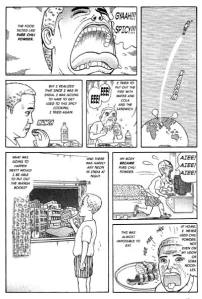
When I was about nine or ten years old my family bought its first video player, my parents got it for Christmas. But the only video we had to watch that Christmas was a cartoon version of George Orwell’s Animal Farm–my dad being an English teacher, he had brought it home from school. I’m the oldest child in my family, so my brother was about eight, and my sister would’ve been about five. Animal Farm is NOT a story for young children, not even in cartoon form, and I know we all have frightened memories of that Christmas, of the horse being taken to the glue factory! A few years later, Orwell’s 1984 is the first adult book I can remember reading, aged 13. I had been reading Sweet Valley High until then, much to the annoyance of my father (see how they turn out?)! I’m not sure I entirely understood the novel, but I had been told the storyline by my mum, so understood the concept, if not the execution. But despite Orwell filling in a couple of these firsts, I hadn’t read anything else of his until I picked up this copy of Burmese Days in Phnom Penh.
The novel is based in a small-town British jungle outpost in Burma in the 1930s. The main protagonist is John Flory, a close-to-middle-aged single man who doesn’t fit in with the other imperial bureaucrats and military-men in town, but can’t quite bring himself to defy them in the ways he would like to:
“In the end the secrecy of your revolt poisons you like a secret disease. Your whole life is a life of lies. Year after year you sit in Kipling-haunted little Clubs, whisky to the right of you, Pink’un to the left of you, listening and eagerly agreeing while Colonel Bodger develops his theory that these bloody Nationalists should be boiled in oil. You hear your Oriental friends called ‘greasy little babus’, and you admit, dutifully, that they are greasy little babus. You see louts fresh from school kicking grey-haired servants. The time comes when you burn with hatred of your own country-men, when you long for a native rising to drown their Empire in blood. And in this there is nothing honourable, hardly even any sincerity. For, au fond, what do you care if the Indian Empire is a despotism, if Indians are bullied or exploited? You only care because the right of free speech is denied you. You are a creature of the despotism, a pukka sahib, tied tighter than a monk or a savage by an unbreakable system of tabus.” (p. 69)
Burmese Days critiques the arrogance and debauchery of the waning years of empire, and also serves as a good period piece, reminding us how British women were treated as chattel, ‘natives’ as little more than animals, and dissent within the ranks was not tolerated. I was also surprised by how entwined in ‘India’ Burma was back then: I knew it had been administratively treated as part of British India, but it was interesting to note the intermingling of the Burmese and Urdu languages in the life and administration of British Burma.
Burmese Days is an enjoyable and readable book, but there are good reasons why this, his first novel, doesn’t have the iconic status of Animal Farm or 1984. Like these novels it, too, is prescient and biting, but Burmese Days’ twilight-of-the-empire critique is overshadowed by its near-contemporary, A Passage to India. The plot and sense of place evoked in E. M. Forster’s classic is just more memorable. Nevertheless, Burmese Days is an intelligent book, and perhaps unfairly out-of-fashion these days. There are still discernible truths within it, appearing in private discussion in neo-post-colonial ex-pat culture in the ‘third world’, if not the official line any more: “He had forgotten that most people can be at ease in a foreign country only when they are disparaging the natives.” (p. 118) Recognisable sentiments like this help the contemporary culturally-western reader resist the temptation to look back on the times narrated in the novel and think ‘how far we’ve come’.










